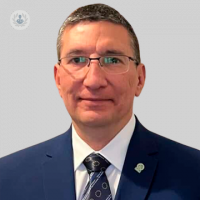Could your child have sleep apnoea?
Escrito por:Sleep apnoea, though often associated with adults, can also affect children, leading to significant disruptions in their health and daily lives. This condition occurs when a child’s breathing is wholly or partially obstructed during sleep, often resulting in fragmented, poor-quality rest. Sleep apnoea can impact a child's growth, behaviour, and learning abilities if left untreated.
Leading GP with a special interest in sleep medicine, Professor Carlos Rivas Echeverria, addresses parents' concerns about sleep apnoea in children.

What are the signs of sleep apnoea in children?
Children with sleep apnoea may show a range of symptoms, some of which can be subtle. Snoring is one of the most common signs, especially if it is loud or irregular. Parents may notice pauses in breathing or gasping for air during the night. Restlessness while sleeping and unusual sleeping positions, such as sleeping with the neck extended, can also indicate breathing difficulties.
During the day, children with sleep apnoea often exhibit symptoms linked to poor sleep. These may include excessive sleepiness, irritability, or trouble concentrating. In some cases, the condition may mimic attention-deficit hyperactivity disorder (ADHD), as children may become hyperactive or have behavioural issues.
What causes sleep apnoea in children?
The most common cause of sleep apnoea in children is obstructive sleep apnoea (OSA), which occurs when the airway is blocked during sleep. Enlarged tonsils and adenoids—lymphatic tissues located in the throat and behind the nasal passages—are often the culprits. These tissues can obstruct airflow, particularly during sleep when muscles relax.
Other risk factors include obesity, allergies, or structural abnormalities of the airway. Children with certain medical conditions, such as Down syndrome or cerebral palsy, may also be more prone to developing sleep apnoea.
How is sleep apnoea diagnosed?
Diagnosing sleep apnoea typically begins with a discussion of your child’s symptoms with a healthcare professional. They may recommend a referral to a specialist, such as a sleep physician.
A sleep study can be done to measure various bodily functions while your child sleeps, including breathing patterns, oxygen levels, and brain activity. While it sounds complex, sleep studies are non-invasive and often conducted in a comfortable, child-friendly environment.
If OSA is diagnosed with the test, Professor Carlos Rivas Echeverría, may recommend your child to a specialist, such as an ear, nose, and throat (ENT) doctor.
What are the treatment options?
Treatment for sleep apnoea in children depends on the severity of the condition and its underlying cause. For many children, surgical removal of the tonsils and adenoids (a procedure known as adenotonsillectomy) is highly effective.
If surgery is not suitable or fully effective, other treatments may include continuous positive airway pressure (CPAP) machines. These machines keep the airway open by delivering a steady air flow through a mask. Lifestyle changes, such as weight management or treating allergies, can also help alleviate symptoms.
Early diagnosis and treatment of sleep apnoea are crucial to ensure your child’s overall well-being. By addressing the condition promptly, you can help them achieve better sleep and physically and emotionally thrive.
If you are concerned that your child suffers from sleep apnoea, you can book a consultation with Professor Echeverría via his Top Doctors profile today.


